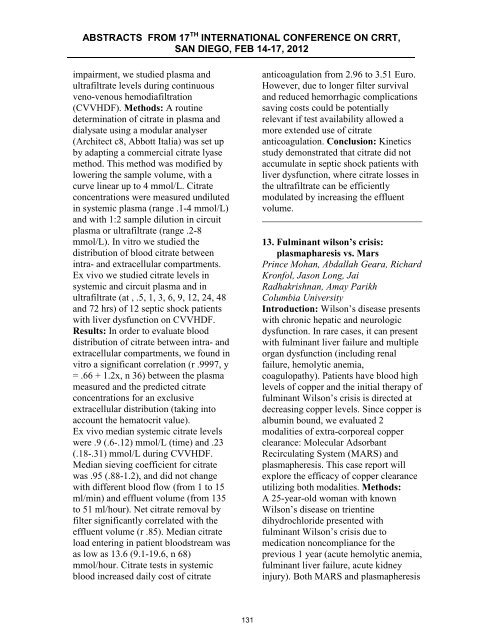ABSTRACTS from 16th International COnference on ... - CRRT Online
ABSTRACTS from 16th International COnference on ... - CRRT Online
ABSTRACTS from 16th International COnference on ... - CRRT Online
You also want an ePaper? Increase the reach of your titles
YUMPU automatically turns print PDFs into web optimized ePapers that Google loves.
<str<strong>on</strong>g>ABSTRACTS</str<strong>on</strong>g> FROM 17 TH INTERNATIONAL CONFERENCE ON <strong>CRRT</strong>,<br />
SAN DIEGO, FEB 14-17, 2012<br />
impairment, we studied plasma and<br />
ultrafiltrate levels during c<strong>on</strong>tinuous<br />
veno-venous hemodiafiltrati<strong>on</strong><br />
(CVVHDF). Methods: A routine<br />
determinati<strong>on</strong> of citrate in plasma and<br />
dialysate using a modular analyser<br />
(Architect c8, Abbott Italia) was set up<br />
by adapting a commercial citrate lyase<br />
method. This method was modified by<br />
lowering the sample volume, with a<br />
curve linear up to 4 mmol/L. Citrate<br />
c<strong>on</strong>centrati<strong>on</strong>s were measured undiluted<br />
in systemic plasma (range .1-4 mmol/L)<br />
and with 1:2 sample diluti<strong>on</strong> in circuit<br />
plasma or ultrafiltrate (range .2-8<br />
mmol/L). In vitro we studied the<br />
distributi<strong>on</strong> of blood citrate between<br />
intra- and extracellular compartments.<br />
Ex vivo we studied citrate levels in<br />
systemic and circuit plasma and in<br />
ultrafiltrate (at , .5, 1, 3, 6, 9, 12, 24, 48<br />
and 72 hrs) of 12 septic shock patients<br />
with liver dysfuncti<strong>on</strong> <strong>on</strong> CVVHDF.<br />
Results: In order to evaluate blood<br />
distributi<strong>on</strong> of citrate between intra- and<br />
extracellular compartments, we found in<br />
vitro a significant correlati<strong>on</strong> (r .9997, y<br />
= .66 + 1.2x, n 36) between the plasma<br />
measured and the predicted citrate<br />
c<strong>on</strong>centrati<strong>on</strong>s for an exclusive<br />
extracellular distributi<strong>on</strong> (taking into<br />
account the hematocrit value).<br />
Ex vivo median systemic citrate levels<br />
were .9 (.6-.12) mmol/L (time) and .23<br />
(.18-.31) mmol/L during CVVHDF.<br />
Median sieving coefficient for citrate<br />
was .95 (.88-1.2), and did not change<br />
with different blood flow (<str<strong>on</strong>g>from</str<strong>on</strong>g> 1 to 15<br />
ml/min) and effluent volume (<str<strong>on</strong>g>from</str<strong>on</strong>g> 135<br />
to 51 ml/hour). Net citrate removal by<br />
filter significantly correlated with the<br />
effluent volume (r .85). Median citrate<br />
load entering in patient bloodstream was<br />
as low as 13.6 (9.1-19.6, n 68)<br />
mmol/hour. Citrate tests in systemic<br />
blood increased daily cost of citrate<br />
anticoagulati<strong>on</strong> <str<strong>on</strong>g>from</str<strong>on</strong>g> 2.96 to 3.51 Euro.<br />
However, due to l<strong>on</strong>ger filter survival<br />
and reduced hemorrhagic complicati<strong>on</strong>s<br />
saving costs could be potentially<br />
relevant if test availability allowed a<br />
more extended use of citrate<br />
anticoagulati<strong>on</strong>. C<strong>on</strong>clusi<strong>on</strong>: Kinetics<br />
study dem<strong>on</strong>strated that citrate did not<br />
accumulate in septic shock patients with<br />
liver dysfuncti<strong>on</strong>, where citrate losses in<br />
the ultrafiltrate can be efficiently<br />
modulated by increasing the effluent<br />
volume.<br />
13. Fulminant wils<strong>on</strong>’s crisis:<br />
plasmapharesis vs. Mars<br />
Prince Mohan, Abdallah Geara, Richard<br />
Kr<strong>on</strong>fol, Jas<strong>on</strong> L<strong>on</strong>g, Jai<br />
Radhakrishnan, Amay Parikh<br />
Columbia University<br />
Introducti<strong>on</strong>: Wils<strong>on</strong>’s disease presents<br />
with chr<strong>on</strong>ic hepatic and neurologic<br />
dysfuncti<strong>on</strong>. In rare cases, it can present<br />
with fulminant liver failure and multiple<br />
organ dysfuncti<strong>on</strong> (including renal<br />
failure, hemolytic anemia,<br />
coagulopathy). Patients have blood high<br />
levels of copper and the initial therapy of<br />
fulminant Wils<strong>on</strong>’s crisis is directed at<br />
decreasing copper levels. Since copper is<br />
albumin bound, we evaluated 2<br />
modalities of extra-corporeal copper<br />
clearance: Molecular Adsorbant<br />
Recirculating System (MARS) and<br />
plasmapheresis. This case report will<br />
explore the efficacy of copper clearance<br />
utilizing both modalities. Methods:<br />
A 25-year-old woman with known<br />
Wils<strong>on</strong>’s disease <strong>on</strong> trientine<br />
dihydrochloride presented with<br />
fulminant Wils<strong>on</strong>’s crisis due to<br />
medicati<strong>on</strong> n<strong>on</strong>compliance for the<br />
previous 1 year (acute hemolytic anemia,<br />
fulminant liver failure, acute kidney<br />
injury). Both MARS and plasmapheresis<br />
131
















